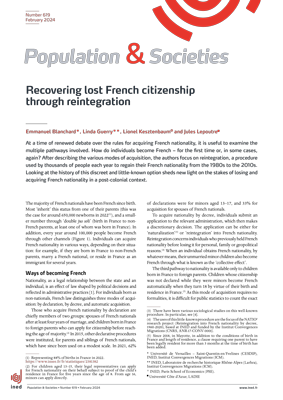Recovering lost French citizenship through reintegration
Press release Published on 26 February 2024

Authors: Emmanuel Blanchard, Linda Guerry, Lionel Kesztenbaum, Jules Lepoutre
At a time of renewed debate over the rules for acquiring French nationality, it is useful to examine the multiple pathways involved. After describing the various modes of acquisition, the authors of this issue of Population and Societies focus on reintegration, a procedure used by more than 200,000 people since the early 1960s to regain their lost French citizenship.
Ways of becoming French
The majority of French nationals have been French since birth, in most cases by ‘inheriting’ this status from one of their parents (this was the case for around 650,000 newborns in 2022, representing 88% of births in France). In addition, every year around 100,000 people become French through other channels.
French law distinguishes three modes of acquisition of French nationality: by declaration, by decree, and by automatic acquisition. Those who acquire French nationality by declaration are chiefly spouses of French nationals, after at least four years of marriage (33% of declarations in 2021), and children born in France to foreign parents who can apply for citizenship before reaching the age of majority (62% of declarations). French nationality can also be acquired by decree, through processes of ‘naturalization’ or ‘reintegration’. Automatic acquisition, the third pathway to nationality, is available solely to children born in France to foreign parents and whose French citizenship was not declared while they were minors. It concerns a few thousand people each year.
Reintegration: the sources of a little-known procedure
The modern legal framework of reintegration began with the Civil Code in 1804. The aim was to enable individuals who had lost their French nationality for geopolitical reasons to recover their citizenship, at a time when the borders of the Napoleonic Empire were unstable. The term ‘reintegration’ appeared for the first time in the law of 26 June 1889 on French nationality. Its meaning and modalities have changed little since then.
Between 1889 and the 1960s, around 120,000 women who had lost their French nationality after marriage regained their citizenship by decree. The automatic loss of nationality upon marriage to a foreign national was abrogated in 1927 (with certain exceptions) and the number of women who were reintegrated decreased steadily up until the 1960s. In that same decade, reintegration by decree entered a new phase linked to decolonization.
Reintegration in the post-colonial period
The transitions to independence led to mass changes in nationality that were neither instantaneous nor always definitive. Beginning in 1967, for example, Algerians born before independence who had emigrated to metropolitan France but who had not opted for French nationality in 1962 were able to apply for ‘reintegration’ by decree. This led to a steady rise in this mode of acquisition over the following years; between 1980 and 2010, it accounted for between 4 and 7% of all acquisitions. Among reintegrated individuals, a large share are of Algerian origin, but many are also from Vietnam and from the former French overseas territories. The number of reintegrations peaked at more than 10,000 in 2005 before gradually declining. In 2020, fewer than 800 people regained their French nationality in this way.
Authors: Emmanuel Blanchard (Université de Saint-Quentin-en-Yvelines, Ined, Institut Convergences Migrations [ICM]), Linda Guerry (Ined, Laboratoire de recherche historique Rhône-Alpes [Lahra]), Institut Convergences Migrations [ICM], Lionel Kesztenbaum (Ined, École d’économie de Paris [PSE]), Jules Lepoutre (Université Côte d’Azur, LADIE)
Published on: 28/02/2024








